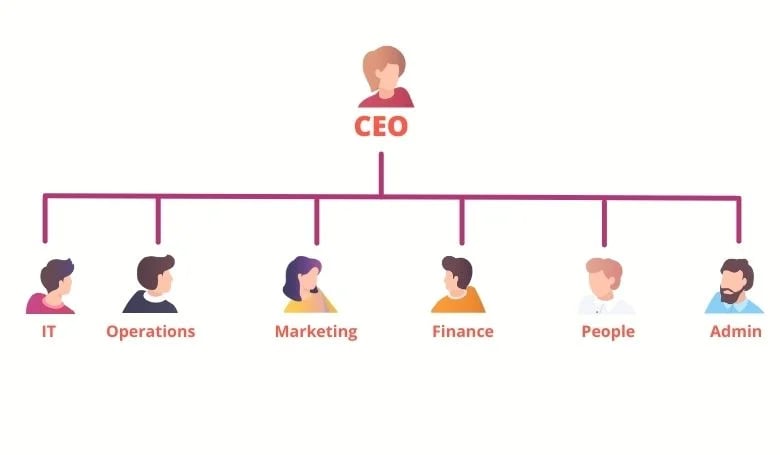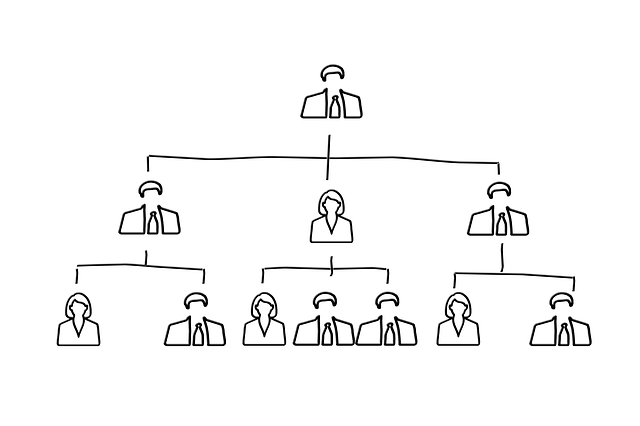Key Takeaways
Hierarchical organizational structures establish a clear chain of command with defined levels of authority, unlike flat structures where employees are relatively equal in authority.
-
Creating a hierarchy chart can be efficiently accomplished using specialized software like Functionly, which offers drag-and-drop mapping tools that integrate with commonly used business applications.
-
Primary benefits include clearly defined responsibilities, established reporting relationships, simplified communication channels, and visible career progression paths for employees.
-
Hierarchical structures work well for both large organizations and growing small businesses, as they scale more easily than transitioning between different organizational models.
-
Implementation best practices include defining your business structure first, organizing departments appropriately based on company size, and creating clear internal career growth opportunities.
-
Unlike flowcharts (which document processes), hierarchy charts function as living documents showing organizational relationships, chain of command, and reporting structures.
-
Functionly's intelligent org chart creation tools allow organizations to test various hierarchical structures, work designs, and reporting lines before implementation, with a free option to get started.
Introduction
A hierarchical structure is a way to organize the chain of command in your company. With this type of structure, there's a set order that dictates the level of authority for each employee in your organization.
Other structures work differently. For instance, in a flat structure there is no real hierarchy. There might be one person who owns the company or who has ultimate authority. But otherwise, in a flat structure, employees are basically equal. They don't answer to other employees or report on their progress to a chain of command.
Flat Hierarchy (very few layers)
 With the hierarchical structure, the chain of command is clearly defined. Each position has a job description and answers to specific superiors above them.
With the hierarchical structure, the chain of command is clearly defined. Each position has a job description and answers to specific superiors above them.
In this post, we'll discuss the hierarchical structure in detail. You'll learn how to go about creating a hierarchy organizational chart so that you can easily start the process today. We'll also give you guides and best practices to help you understand the benefits and disadvantages of this type of structure.
How to Create a Hierarchy Chart
Creating a hierarchy chart doesn't need to be as difficult as it sounds. You can create a living document through several types of software. For instance with Functionly, our drag and drop mapping helps you align all of your people in the right positions easily. You can create a full organization hierarchy chart in minutes with a program that integrates with the tools you routinely use.
Your hierarchy chart will look similar to a pyramid, depending on how large your organization is.
Often we see one CEO at the head, with several department heads that answer directly to the CEO. Below those department heads, you might have a series of managers.
Below the managers might be supervisors, and below those roles, you would have staff. This might be different for your company, depending on the size. In a smaller company, you might have managers that answer directly to the CEO, and employees directly beneath them.

Traditional Tall Hierarchy (lots of layers). Image by Gerd Altmann from Pixabay
The benefit of using a hierarchy structure is that there is a clear, delineated chain of command. There should never be any confusion about responsibility. Specific employees take ownership of projects. This structure makes it easier to organize tasks and follow them through to completion.
With a hierarchy structure, there is also a granting of access and set responsibilities.
In most companies, the head of the department answers for the whole department. They would be in charge of overseeing all the managers and supervisors below them. The managers and supervisors would then be delegated with the authority to oversee staff below them.
This structure gives employees a clear direction. Each employee knows who to communicate with about their job. It also sets up a career progression path for employees. If you're a company that promotes from within, you can train employees throughout your organization as they move to positions of more authority.
Guide & Best Practices for Laying out a Hierarchical Structure
There are several types of structures that your company can choose. The hierarchical structure makes the process clear for employees and for management. Staff can easily see what their job responsibilities are and who they report to. This simplifies the workflow in a larger organization.
This is also a structure that works well for smaller businesses that are planning to grow. It's easier to begin with a hierarchical structure in place and add to it as you scale than it would be to change from one structure to an entirely different one.
The first step is to define your business structure. This will dictate the type of hierarchy that fits your model best.
For example, does your company answer to a board or one CEO? If you have a board of directors, the executives will run day-to-day operations but then answer to the board of directors. In these cases, a hierarchical structure may work better than a flat structure.
There can be many variables to the way that you organize departments and the number of people in leadership roles. Many of these decisions depend on the size of your business and whether you need to organize several departments or product types.
One benefit to the hierarchy structure is that it allows you to clearly define internal career growth. For hiring, being able to showcase a company that promotes from within and values providing employees with opportunities to grow professionally makes the organization more attractive for high-quality talent.
With a well-organized structure, you can foster stronger bonds between team members and build a company culture where departments work together productively. Ideally, your hierarchy chart gives staff an understanding of what’s expected and who holds authority in each department.
Interactive Org Chart - use tools to zoom, view job details, etc... ©Functionly
What can you do with a Hierarchy Chart?
The hierarchy chart is used to show the chain of command and positions within the company. It’s laid out in an easy-to-see, visual format. This gives your staff a tool so that they understand who to go to with questions, who their superior is on any set project, and where they fit into the organization.
The hierarchy chart is also not set in stone. Your organization can expand and edit this chart as employees leave and new positions are created. For management and executives, it provides a clear overview of how the organization works to fill holes and add positions as needed.
A good organizational chart can be used to help in decisions about hiring, cross-training, and promoting staff members.
How Is it different from a Flow Chart?
In programming, both hierarchy charts and flow charts are used. In business, the hierarchy chart would be used to showcase the structure of the chain of command for the company. A flowchart might be used to visually explain a process.
There is a distinct difference. Hierarchy charts are laid out somewhat like a family tree. There is a head, and then the relationships beneath move forward in subsequent generations. These charts are designed to document the specific roles, how they relate to each other, and who they parent or supervise.
A flow chart doesn’t showcase the same hierarchy. It’s often used to show the way a process works. The flow chart provides a quick overview of how a task should be completed from start to finish. It's a good method for training purposes. Flowcharts can also be highly effective when there are set processes that don’t need to be completed regularly. Staff members can refresh their knowledge so no steps are missed.

Flow Chart (shows processes) Image by Gerd Altmann from Pixabay
A hierarchy chart acts as a reference and living representation of the current company and staff. It’s an excellent resource for new hires, the HR department, and as it relates to decisions about expansion or elimination of departments.
Designing your own Hierarchy Chart
Whatever hierarchy chart you think is right for your organization, you can run various options using Functionly's intelligent org chart creation tools. Either on your own, or with the entire team, you can plan out and test the best structure, work design, reporting lines and overall organizational (hierarchy) chart.
Get started for free, and start creating your org today.
Learn about other org charts.
~~
Source
- Types of Organizational Structures to Consider for Your Business, Max Freedman, Business News Daily, 5 Sep 2020
Photo Credits
Title header photo: Image by Gerd Altmann from Pixabay




